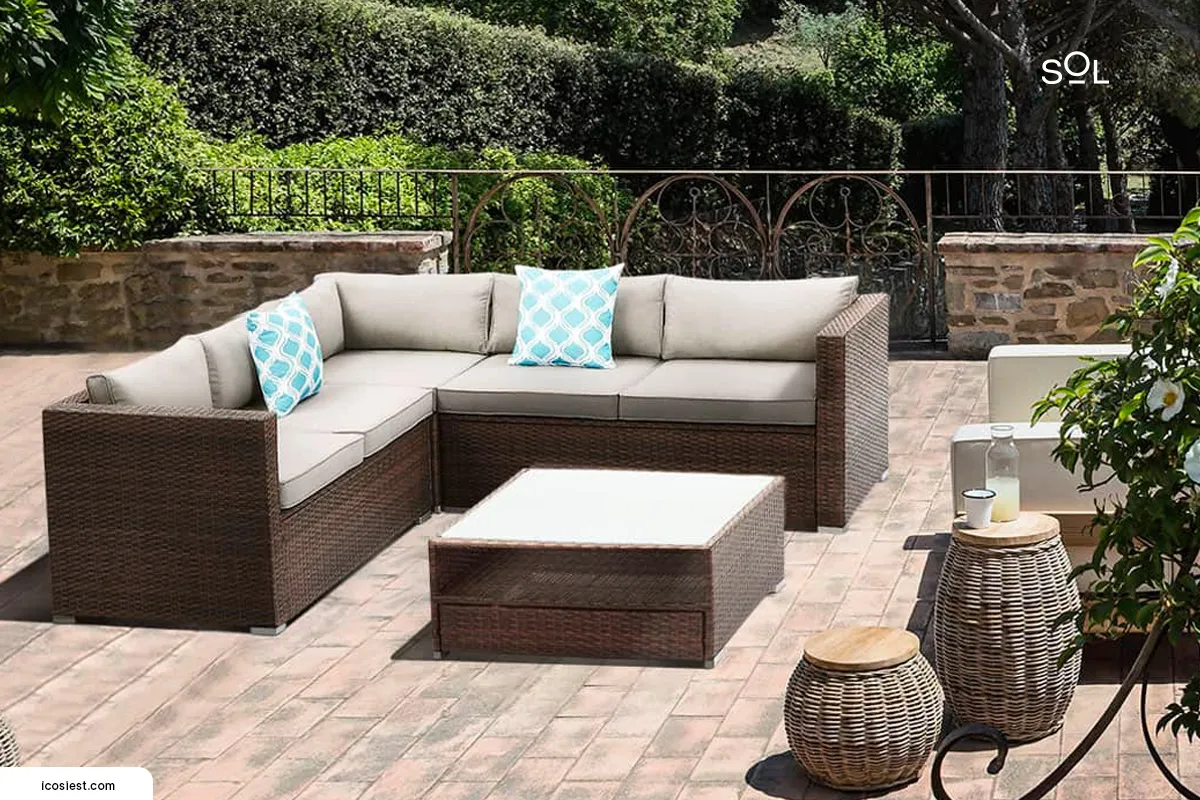How to repair plastic wicker furniture – Tired of your plastic wicker furniture looking a little worse for wear? Don’t toss it out just yet! We’re about to spill the tea on how to give those chairs, tables, and loungers a second life. Think of it as a mini-makeover for your outdoor space.
Ready to get your DIY on? Let’s dive in!
From tackling tears and cracks to replacing broken strands, we’ll walk you through the process step-by-step. We’ll even cover how to bring back that fresh-out-the-box shine. Trust us, your patio will be looking so good, your neighbors will be jealous.
Identifying Damage
Before embarking on any repair process, it’s crucial to accurately identify the type and extent of damage to your plastic wicker furniture. Understanding the specific issues will guide your repair approach and ensure the most effective solution.
Types of Damage
Plastic wicker furniture is generally durable, but it can experience wear and tear over time. Here are some common types of damage:
- Cracks:These can occur due to impact, exposure to extreme temperatures, or prolonged UV exposure. Cracks can be small and hairline or large and deep, potentially compromising the structural integrity of the piece.
- Tears:Tears often result from sharp objects or excessive force. They can affect the wicker strands, creating holes or unraveling the weave.
- Fading:Prolonged exposure to sunlight can cause the plastic to fade, resulting in a discoloration or loss of vibrancy in the original color.
- Loose or Broken Wicker Strands:These can be caused by wear and tear, impact, or simply the natural aging of the material. Loose strands can easily become detached, while broken strands may need to be replaced.
Inspecting for Structural Integrity
Once you’ve identified the damage, it’s essential to assess the overall structural integrity of the furniture. This involves:
- Checking for wobbly legs or joints:If the furniture wobbles or feels unstable, it indicates potential issues with the frame or connections.
- Examining the wicker weave:Look for any significant gaps or loose strands that could compromise the strength of the weave.
- Testing the weight capacity:Gently apply pressure to different areas of the furniture to assess its ability to support weight.
Tip:When inspecting, it’s helpful to use a flashlight to illuminate areas that might be difficult to see.
Tools and Materials: How To Repair Plastic Wicker Furniture

Repairing plastic wicker furniture requires a specific set of tools and materials to ensure a successful and durable repair. The right tools and materials will make the repair process easier and more efficient.
Essential Tools and Materials
| Tool/Material | Description | Purpose | Availability |
|---|---|---|---|
| Scissors | Sharp, pointed scissors for cutting plastic wicker strands. | Used to trim and cut plastic wicker strands to the desired length for repairs. | Widely available at hardware stores, craft stores, and online retailers. |
| Wire Cutters | Heavy-duty wire cutters for cutting metal wire or cable ties. | Used to cut metal wire or cable ties that may be holding the wicker together. | Widely available at hardware stores, auto parts stores, and online retailers. |
| Pliers | A pair of pliers with adjustable jaws for gripping and manipulating small objects. | Used to hold and manipulate plastic wicker strands while making repairs. | Widely available at hardware stores and online retailers. |
| Screwdriver | A screwdriver with a Phillips head for loosening and tightening screws. | Used to remove and replace screws that may be holding the wicker together. | Widely available at hardware stores and online retailers. |
| Epoxy Resin | A two-part epoxy resin that cures to a strong, durable bond. | Used to repair broken or cracked plastic wicker strands. | Available at hardware stores, craft stores, and online retailers. |
| Plastic Wicker Repair Tape | A special tape designed for repairing plastic wicker furniture. | Used to reinforce repaired areas and prevent further damage. | Available at home improvement stores, online retailers, and some furniture stores. |
| Sandpaper | Fine-grit sandpaper for smoothing out rough edges. | Used to smooth out rough edges on repaired areas. | Widely available at hardware stores and online retailers. |
| Paint | Matching paint for the furniture to touch up repaired areas. | Used to blend repaired areas with the rest of the furniture. | Available at home improvement stores, paint stores, and online retailers. |
| Cleaning Supplies | Mild soap, water, and a soft cloth for cleaning the furniture before and after repairs. | Used to remove dirt, debris, and any loose strands before repairs and to clean up any excess resin or glue. | Widely available at grocery stores and online retailers. |
Repairing Tears and Cracks

Tears and cracks in plastic wicker furniture can be unsightly and compromise the structural integrity of the piece. However, with the right tools and techniques, these damages can be effectively repaired, restoring the furniture’s appearance and functionality.
Repairing Tears and Cracks, How to repair plastic wicker furniture
The process of repairing tears and cracks in plastic wicker furniture involves cleaning and preparing the damaged area, followed by applying an epoxy resin or a similar adhesive to mend the tear or crack.
- Clean the damaged area.Use a damp cloth to remove any dirt, debris, or loose fibers. Allow the area to dry completely before proceeding.
- Prepare the damaged area.Roughen up the edges of the tear or crack using sandpaper to create a better surface for the adhesive to bond to. This will help ensure a stronger and more durable repair.
- Apply epoxy resin or a similar adhesive.Apply the adhesive to both sides of the tear or crack, ensuring that it fills the gap completely. Use a putty knife or a similar tool to spread the adhesive evenly.
- Clamp the repair.Use clamps to hold the repair in place while the adhesive dries. The clamps should be applied evenly and firmly, ensuring that the repair is held together securely.
- Allow the adhesive to dry completely.The drying time will vary depending on the adhesive used. Refer to the manufacturer’s instructions for the recommended drying time.
- Sand the repair.Once the adhesive has dried completely, sand the repair area smooth to blend it in with the surrounding surface.
- Paint the repair.If desired, paint the repair area to match the original color of the furniture.
Replacing Broken Wicker Strands
Replacing broken wicker strands is a common repair for plastic wicker furniture. This process involves removing the damaged strands and weaving new ones into the existing frame.
Removing Old Strands
Before replacing broken strands, it is essential to remove the old ones. This process requires careful attention to avoid damaging the surrounding frame.
- Use a pair of pliers or wire cutters to cut the damaged strand as close to the frame as possible.
- If the strand is tightly woven, use a small screwdriver or a similar tool to gently pry it loose from the frame.
- Work slowly and carefully to avoid damaging the surrounding wicker.
Attaching New Strands
Once the old strands are removed, you can begin attaching the new ones. This process involves securing the new strands to the frame and weaving them into the existing pattern.
- Use a strong adhesive, such as epoxy or a heavy-duty glue, to attach the new strand to the frame.
- Ensure that the adhesive is compatible with both the new strand and the frame material.
- Allow the adhesive to dry completely before proceeding with the weaving process.
Weaving New Strands
Weaving the new strands into the existing frame requires patience and attention to detail. This process ensures that the repair is seamless and durable.
- Start by threading the new strand through the existing weave, following the original pattern.
- Use a small needle or a similar tool to help guide the strand through the weave.
- Continue weaving the new strand until it is securely attached to the frame.
- Ensure that the new strand is tightly woven to prevent it from loosening or becoming damaged.
Restoring Color and Finish
Over time, plastic wicker furniture can fade and lose its original vibrancy. Restoring the color and finish can revitalize the piece and make it look like new again. This process involves cleaning, prepping, and applying a suitable finishing product.
Choosing the Right Finishing Product
Selecting the appropriate finishing product depends on the type of plastic wicker and the desired look.
- Paint:For a complete color change, paint is the most versatile option. Acrylic latex paint is recommended for its durability and ease of application.
- Stain:To enhance the natural color and grain of the wicker, a stain can be used. Water-based stains are easier to work with and dry quickly.
- Polyurethane:For a protective finish, polyurethane is a good choice. It forms a clear, durable coating that resists scratches and fading.
- UV-resistant sealant:To protect the furniture from the damaging effects of sunlight, a UV-resistant sealant can be applied. It helps prevent fading and discoloration.
Preventing Future Damage

Plastic wicker furniture, while durable, can be susceptible to damage if not properly cared for. Understanding the common causes of damage and implementing preventative measures can significantly extend the life of your furniture.
Proper Cleaning
Regular cleaning is crucial for maintaining the appearance and structural integrity of your plastic wicker furniture. Dirt, grime, and spills can accumulate over time, leading to discoloration and weakening of the wicker strands.
- Use a mild soap solution and a soft brush to clean the furniture regularly. Avoid harsh chemicals or abrasive cleaners that can damage the plastic.
- Rinse the furniture thoroughly with clean water after cleaning and allow it to air dry completely.
- For stubborn stains, a diluted solution of white vinegar can be used.
Storage
Proper storage can protect your plastic wicker furniture from the elements and prevent damage during the off-season.
- Store furniture in a dry, well-ventilated area. Avoid storing it in damp or humid environments, as this can lead to mold and mildew growth.
- Cover the furniture with a breathable fabric cover to protect it from dust and debris.
- If storing furniture outdoors, ensure it is placed under a covered area or protected from direct sunlight.
Protection from the Elements
Exposure to harsh weather conditions can significantly impact the lifespan of plastic wicker furniture.
- Avoid placing furniture in direct sunlight for extended periods, as UV rays can cause fading and discoloration.
- Cover the furniture during storms or heavy rain to prevent water damage.
- Consider using a protective sealant to enhance the furniture’s resistance to the elements.
Best Practices Checklist
- Clean the furniture regularly with a mild soap solution and a soft brush.
- Rinse thoroughly with clean water and allow to air dry completely.
- Store furniture in a dry, well-ventilated area.
- Cover furniture with a breathable fabric cover during storage.
- Avoid placing furniture in direct sunlight for extended periods.
- Cover furniture during storms or heavy rain.
- Consider using a protective sealant to enhance resistance to the elements.
Ending Remarks

So, there you have it! With a little time and effort, you can transform your worn-out plastic wicker furniture into a stylish statement piece. Remember, a little TLC goes a long way. And hey, if you’re feeling extra ambitious, maybe even give those cushions a makeover too.
Your patio is your canvas – go wild!
FAQ Summary
What’s the best way to clean plastic wicker before repairing it?
A mild soap and water solution will do the trick! Just make sure to rinse it thoroughly after cleaning.
Can I use any type of epoxy resin for repairing cracks?
It’s best to use an epoxy resin specifically designed for plastic. It’ll provide a stronger and more durable bond.
What if I can’t find replacement wicker strands?
Don’t worry! You can often use similar materials like twine or rope. Just make sure it’s durable and weather-resistant.